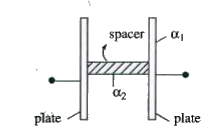A capacitor is to be designed to operate, with constant capacitance, even when temperature varies.The distance between plates is adjusted by spacer to compensate temperature effect. Let α1andα2 be the coefficient of thermal expansion of plate and spacer respectively. Find the ratio of α2α1 . So that no change in capacitance of capacitor with change in temperature.

The correct Answer is:2
Topper's Solved these Questions
- CAPACITORS BOOK - AAKASH SERIESCHAPTER - CAPACITORS EXERCISE - ADDITIONAL PRACTICE EXERCISE (LEVEL - II LECTURE SHEET (ADVANCED))(Matrix Matching Type Questions)
2 Videos
- CAPACITORS BOOK - AAKASH SERIESCHAPTER - CAPACITORS EXERCISE - ADDITIONAL PRACTICE EXERCISE (LEVEL - II LECTURE SHEET (ADVANCED))(Integer Type Questions )
3 Videos
- CAPACITORS BOOK - AAKASH SERIESCHAPTER - CAPACITORS EXERCISE - ADDITIONAL PRACTICE EXERCISE (LEVEL - I (MAIN)(Straight Objective Type Questions)
22 Videos
- ATOMSBOOK - AAKASH SERIESCHAPTER - ATOMSEXERCISE - PRACTICE EXERCISE
21 Videos
- COMMUNICATION SYSTEM BOOK - AAKASH SERIESCHAPTER - COMMUNICATION SYSTEM EXERCISE - LECTURE SHEET (LEVEL - I) (MAIN) (EXERCISE - IV) (Straight Objective & More than one Correct Answer Type Questions)
20 Videos
Similar Questions
A capacitor is to be designed to operate, with constant capacitance, in an environment of fluctuating temperature. As shown in the figure the capacitor is a paralel plate capacitor with 'spacer' to change the distance for compensation of temperature effect. If α1 be the coefficient of linear expansion of plates and α2 that of spacer, find the rate of change of capacitance with temperature and hence find the condition for no change in capacitance with change of temperature. The capacitance of the capacitor is equal to C.

View SolutionThere are two rods of length l1 and l2 and coefficient of linear expansions are α1 and α2 respectively.
Find equivalent coefficient of thermal expansion for their combination in series.
View Solution
Knowledge Check
If L1 and L2 are the lengths of two rods of coefficients of linear expansion α1 and α2 respectively the condition for the difference in lengths to be constant at all temperatures is
AL1α1=L2α2BL1α2=L2α1CL1α1=L2α2DL1α2=L2α1There are two rods of length l1 l2 and coefficient of linear expansions are α1 and α2 respectively.
Find equivalent coefficient of thermal expansion for their combination in series.Aα1+α22Bα1l1+α2l2α1+α2C(α1l1+α2l2)/(l1+l2)D√aplha1α2Two conductors have the same resistance at 0∘C but the temperature coefficients of resistance are α1andα2 The respective temperature coefficients of their series and parallel combinations are nearly
Aα1+α22,α1+α2Bα1+α2,α1+α23Cα1+α23,α1+α2Dα1+α22,α1+α22
Two conductors have the same resistance at 0∘C but their temperature coefficient of resistanc are α1andα2. The respective temperature coefficients of their series and parallel combinations are nearly
View SolutionA parallel plate capacitor of area A and separation d is provided with thin insulating spacers to keep its plates aligned in an environment of fluctuating temperature. If the coefficient of thermal expansion of material of the plate is α, find the coefficient of thernal expansion (αs) of the spacers in order that the capacitance does not vary with temperature. (Ignore effect of the spacers on capacitance.)

View SolutionTwo conductors have the same resistance at 0∘C but their temperature coefficient of resistanc are α1andα2. The respective temperature coefficients of their series and parallel combinations are nearly
View SolutionA copper rod and steel rod having length Lc and Ls respectively at certain temperature. It is observed that difference between their length remains constant at all temperature. If αc and αs ar their respective coefficient of linear expansions. Then, ratio of LsLc is
View SolutionA parallel plate capacitor of area A and separation d is provided with thin insulating spacers to keep its plates aligned in an environment of fluctuating temperature. If the coefficient of thermal expansion of material of the plate is α, find the coefficient of thernal expansion (αs) of the spacers in order that the capacitance does not vary with temperature. (Ignore effect of the spacers on capacitance.)

View Solution
